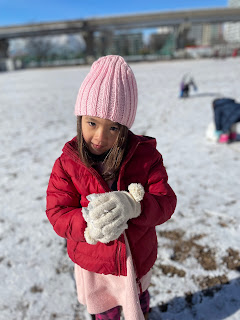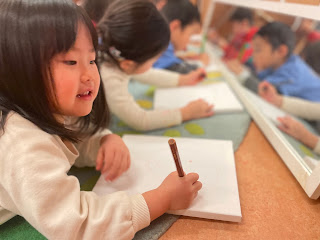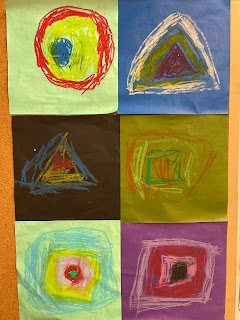20: Elements of Art
I found I could say things with colors and shapes that I couldn't say any other way
-- things I had no words for.
-Georgia O'Keefe
When people express themselves, they share to the outside world a part of who they are. This may be a thought, feeling, or idea that is conveyed through artistic ways such as dance, drama, music, or art. The beauty of self-expression is that it gifts the world with pieces of the artist that come from their diverse experiences and unique personality. Every brush stroke, hue, or figure, when put together, create a composition that reveals much about the artist's story.
The past two weeks, the kindergarteners unleashed their inner artist and explored the different elements of art that they can use to express themselves. We discovered how colors, lines, and shapes can be used to share our thoughts, feelings, and ideas.
ELEMENT 1: COLOR
When used on blank canvas, the colors we use to express ourselves pop and create a vibrant picture for others to appreciate. Two weeks ago, the kindergarteners were gifted with a unique canvas when the cold snap covered the grounds with fresh, fluffy, white snow. We used this opportunity to experiment with color and create little masterpieces that would only last as long as the sun allows it. The children donned their winter gear and got ready for a rare day of play outside, with bottles of liquid watercolor in tow.
There are many studies on how colors can affect people's perception, behavior and even judgment. During one of our Circle Time discussions, one of the children asked me,
"Ms. Pam, why is the color of your hair different?" At that time, I had just changed my hair color back to my original one. I explained that I tried a different hair color a few months ago because I wanted to try something new. One of the children said, "We also have different hair colors. Why?" I tried my best to explain that we inherit our features from our families, and used it as a springboard to our inquiry on how we perceive ourselves and express it through art.
The children used mirrors to draw their own self-portrait and outline their unique features.
We also looked closely into the different colors of our skin, and discovered that we have similar hues and differ only with the tints and shades.
We practiced mixing the right colors to match our skin tone, and the children chose which is closest to the one they have.
It was a beautiful exercise to see that colors are not just an abstract part of who we are, they are ever present and tangible in the different parts of our body, too. The colors we possess and carry with pride (love the skin you're in) are uniquely ours, and they tell a profound history of our families, too.
ELEMENT 2: LINES
When I was finishing my bachelor's degree in Psychology, one of my professors asked us to draw our own self-portrait and analyze ourselves through it. In the process, I discovered the important role that lines play giving us a better glimpse of our psyche. There was a disclaimer from my professor that this tool is not accurate, which I agree with, but I also believe that in expressing ourselves, the lines we draw give definition to the stories we wish to tell.
The kindergarteners began their exploration of lines through a sensorial storytelling activity. We read (or felt? 😆) the book called The Game of Let's Go, which brings its readers on a journey that they have to embark on with their eyes closed. They can only use their finger to follow the lines that lead them to their destination.
We discovered that lines look different. Some are straight, some are curvy, some are slanted, and some look like rollercoasters that have twists and turns. With their buddy for the day, the children took turns in drawing lines on a shared canvas, and used what they learned about color to add life to the spaces that their lines created.
The children also used a different medium to play with lines and see what they can create. They used pipe cleaners to create sculptures of rainbows, gardens, and even rollercoasters!
ELEMENT 3: SHAPES
When lines are enclosed, they turn into shapes that give a different dimension to a piece of art. The kindergarteners reviewed the basic shapes that they know, and learned new ones -- like arches and a crescents. We studied the art of Wassily Kandinsky, one of my favorite artists who used shapes in interesting ways in his art.
The children practiced creating their own concentric shapes inspired by Kandinsky's Squares with Concentric Circles.
We also discovered that there are shapes that look different from the basic ones we know. I shared with the children my love for doodling. I loved doodling, especially when I was younger, as it helps me relax my mind and allows me to let ideas flow naturally. Using clear films, I asked the children to doodle whatever comes to their mind, any shape or image that they would like to express.
We turned their doodles into a stained glass window that added so much character to our regular view of the playground outside.
We also used what we learned about shapes to celebrate Setsubun. Instead of the usual masks that we buy, we asked the children to create their own oni masks using the basic and irregular shapes. Look what they made!
We deepened our inquiry on the different elements of art by inviting an artist to share with us her work and the process behind it. This week, Jessica, Emma's mom, visited Kinder 2 to talk about her illustrations, and her inspiration behind her pieces.
She taught us how to use color, lines, and shapes to make our self-portraits more detailed through a fun game.
We learned from Jessica that the process of creating our art is important. We have to give ourselves time to practice, and we have to find inspiration for our work. We were also reminded by Jessica that we are all artists -- and pretty good ones at that. Thank you for inspiring us, Jessica. 🎨
The process of learning and self-expression is not linear. It even looks different for every individual. One thing that's universal though is that every one of us has a story to tell -- a thought, a feeling, an idea, that has the potential to inspire. If we learn how to express this part of who we are in a way that will move others, we would not have only gifted the world with our artistry, we would leave behind a legacy that could change a life or alter the course of the world for the better.
Your Kindergarten teacher,
Pam











































































Comments
Post a Comment